** UPDATED 7/2023
The black trumpet is one of my favorite wild mushrooms. Don’t let its unremarkable appearance fool you; this is one of the best-tasting fungi you’ll ever find. These mushrooms are gourmet edibles. They have a smoky, rich flavor and a pleasant, fruity aroma. There are no poisonous look-alikes, making this a great mushroom for beginners to identify.
Unfortunately, they’re not always easy to find. Their dark color and strange shape make them look like little black holes on the forest floor. Many a time have people looked right at them without realizing the treat before their very eyes!
The black trumpet mushroom is also known as horn of plenty, trumpet of death, or black chanterelle, and various species grow across the world. Despite its size and difficulty in spotting, the black trumpet is a highly sought-after ingredient in the culinary world, prized for its unique taste and aroma.
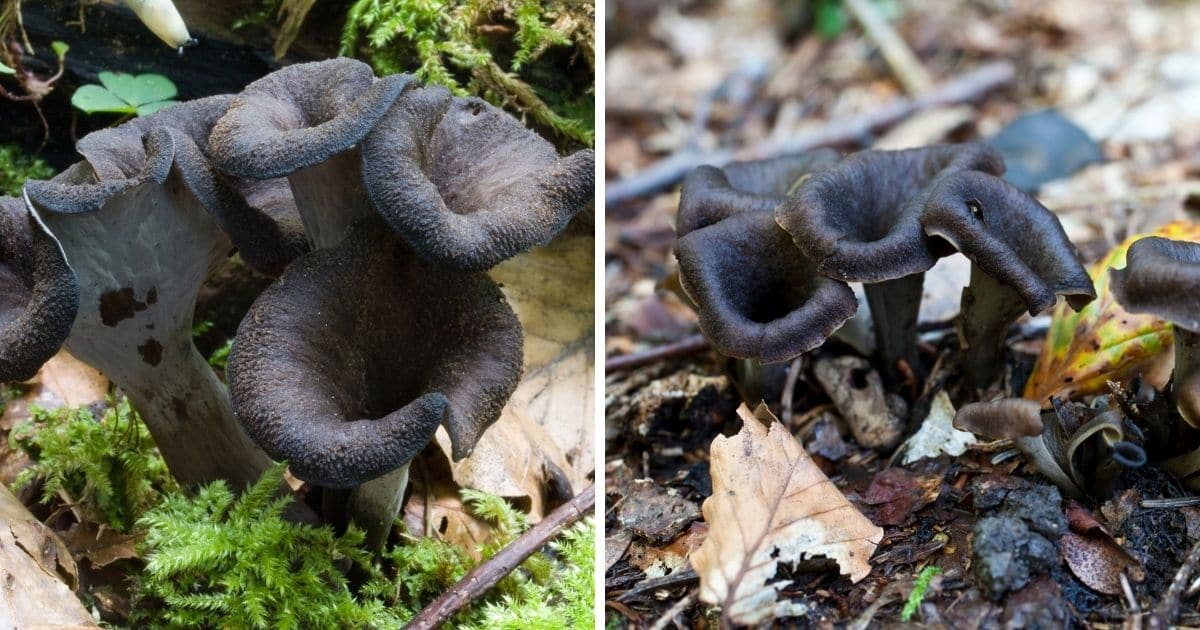
Jump to:
All About Black Trumpet Mushrooms
The Black Trumpet, also known as the Horn of Plenty, Trumpet of the Dead, or Black Chanterelle, has a rich history and fascinating cultural references. The French and Italians call it trompette de la mort or trombetta dei morti, respectively, which translate to “trumpet of the dead”. This somewhat morbid name is believed to stem from the mushroom’s trumpet-like shape, resembling trumpets being played by the deceased from underground.
This mushroom has close relatives across the globe. There’s the eastern North American Craterellus fallax, the Fragrant Trumpet Craterellus foetidus, the Cerulean Black Trumpet Craterellus caeruleofuscus, the California Black Trumpet, and the European Craterellus cornucopioides, all considered choice edible mushrooms and often falling under the general term of “Black Trumpet”.
Many North American identification guides still have the old European name, Craterellus cornucopioides listed as the scientific name for teh species. More recent analysis, though, shows that this is only a European species and the North American ones are separate.


Basic Black Trumpet Facts
- They’re shaped like a funnel and come in a brown, gray, or black color. The edges of the cap are rolled outwards and wavy.
- One of the most noticeable things about black trumpets is that they have no gills or other visible spore-bearing structures (such as pores or teeth). The underside of their caps will always be smooth to slightly wrinkled.
- They’re thought to be both saprotrophic (feeding on dead organic matter) and mycorrhizal (creating symbiotic relationships with the roots of plants). Their precise ecological role is not yet fully understood.
- They’re closely related to chanterelles which is why they’re also known as the “black chanterelle”.

Foraging Black Trumpets
Identification of black trumpets is not very difficult. Finding them, however, can be.
That’s not because they fruit in remote places. You may have an incredible patch of black trumpets nearby. Yet their minute size and dark gray appearance make them very hard to spot on the forest floor.
The trick to finding them lies in knowing where and how to look. Keep these tips in mind when choosing a mushroom hunting location:
- Hardwood forests, especially near oak and beech. These mushrooms do not fruit on wood, but near it. You won’t find a lot of black trumpets at the very base of a tree.
- Near mossy areas. I’ve often found them fruiting in or near patches of thick green moss on the side of trails. The contrast of their dark color against the moss makes them easier to see.
- Near washes and small streams. On the edge of small streams on hills and trails is a great place to look. They seem to like damp, dark areas. No roaring rivers, just smaller seasonal streams.
- When looking, walk slowly and look directly down. They are very easy to miss unless you’re standing right over them. Take your time when examining the leaf litter.
- They grow in clusters, especially on the West Coast. So if you find one, stop and carefully look around. There may be many more nearby.


Black Trumpet Mushroom Identification
As for identification, there are no poisonous look-alikes. This fact, along with their unique appearance, makes them a good mushroom for beginners.
Examine the pictures and the list of identification features below. You’ll quickly get a feel for how they should look. That said if you’re a true beginner always check with an expert before eating something you find. I never support mushroom identification based solely on what you’ve read on the Internet. Even with mushrooms as tasty as these!
Season
The foraging season of Black Trumpets varies based on location. On the east coast, the season ranges from mid-July through late August, while on the west coast, they are winter mushrooms, starting in November and going through March. These mushrooms prefer cooler temperatures and will only grow when they feel the conditions are right.
Habitat
Black Trumpets are mycorrhizal mushrooms, meaning they form a symbiotic relationship with trees. Specifically, the east coast Black Trumpet grows with oaks, while the western ones grow in association with conifers and hardwoods. They often grow in mossy forest floors but are also known to grow in sandy areas along coasts.
These mushrooms only grow from the ground, never on trees or from wood or logs. They appear singularly in large scattered groupings, like a band of little soldiers on the forest floor. Sometimes, one or two might fuse together, but primarily, they grow individually.

Cap
Funnel or vase-shaped with a gray, brown, or black color. They sometimes flare out at the end with wavy or ruffled edges. As they age and dry out, these edges frequently split. The underside is just a smooth surface with no gills, pores, or teeth. The inside of the cap may or may not be covered in small scales.
Gills
Unlike many mushrooms, Black Trumpets lack true gills. Instead, they have forked ridges or folds that run from the underside of the cap down the stem, appearing as textured skin rather than hanging gills.
Stem
The stem of a Black Trumpet is hollow, thin, and skinny. There is no obvious cap or stem differentiation, unlike most other mushrooms. It is ups to a few inches tall and the same color, or just slightly lighter than, the cap. The flesh itself is thin and easily broken.
Texture
Take special note of the texture of the black trumpet. They’re smooth or just slightly wrinkled with a soft feel to them. I think they feel a lot like suede.
Odor and Taste
Black Trumpets have a mild taste and an odor that is not distinctive, or somewhat fragrant.
Flesh
The flesh of a Black Trumpet is very thin and breaks easily. It’s gray to blackish in color.
Spore Print
White to a pinkish salmon color.



Black Trumpet Species in North America
There are three main species of black trumpets in North America. They all go by the common name black trumpet and look quite similar. The primary differences are location (east coast vs. west coast) and habitat.
Craterellus fallax (East Coast)
This black trumpet mushroom is mycorrhizal with oaks and likely other hardwoods. It grows alone, scattered, gregariously, or in loose clusters in mossy areas and can be found from spring through fall. The mushroom is widely distributed east of the Rocky Mountains. It averages 1-3.5 inches tall.
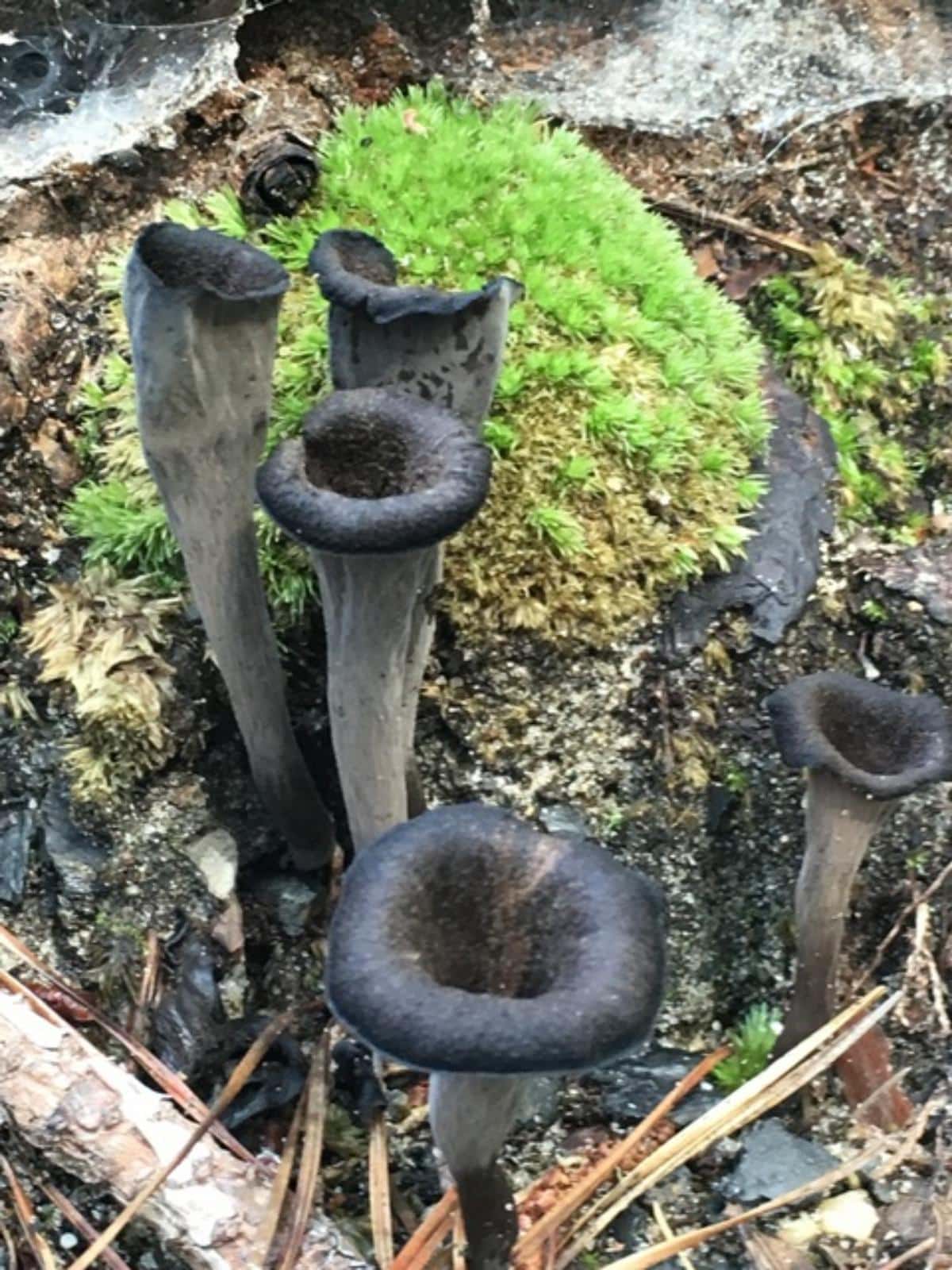
Craterellus foetidus (East Coast)
Unlike other black trumpet species, this one has clearer and more developed wrinkles and folds along the top of the stem, although they still tend to be rather faint or modest-looking. It is usually bigger than C. fallax and tends to grow in small clusters of 2-4 specimens, conjoined at the stem. At least, it is more likely to do this than C. fallax. It ranges from 1-4 inches tall.
Young fruiting bodies, or ones growing in overly dry conditions, might be pale to the point of almost white — this isn’t uncommon but it doesn’t happen all the time, either. This often leads to confusion, since the mushrooms take awhile to mature and stay at that light stage for awhile.
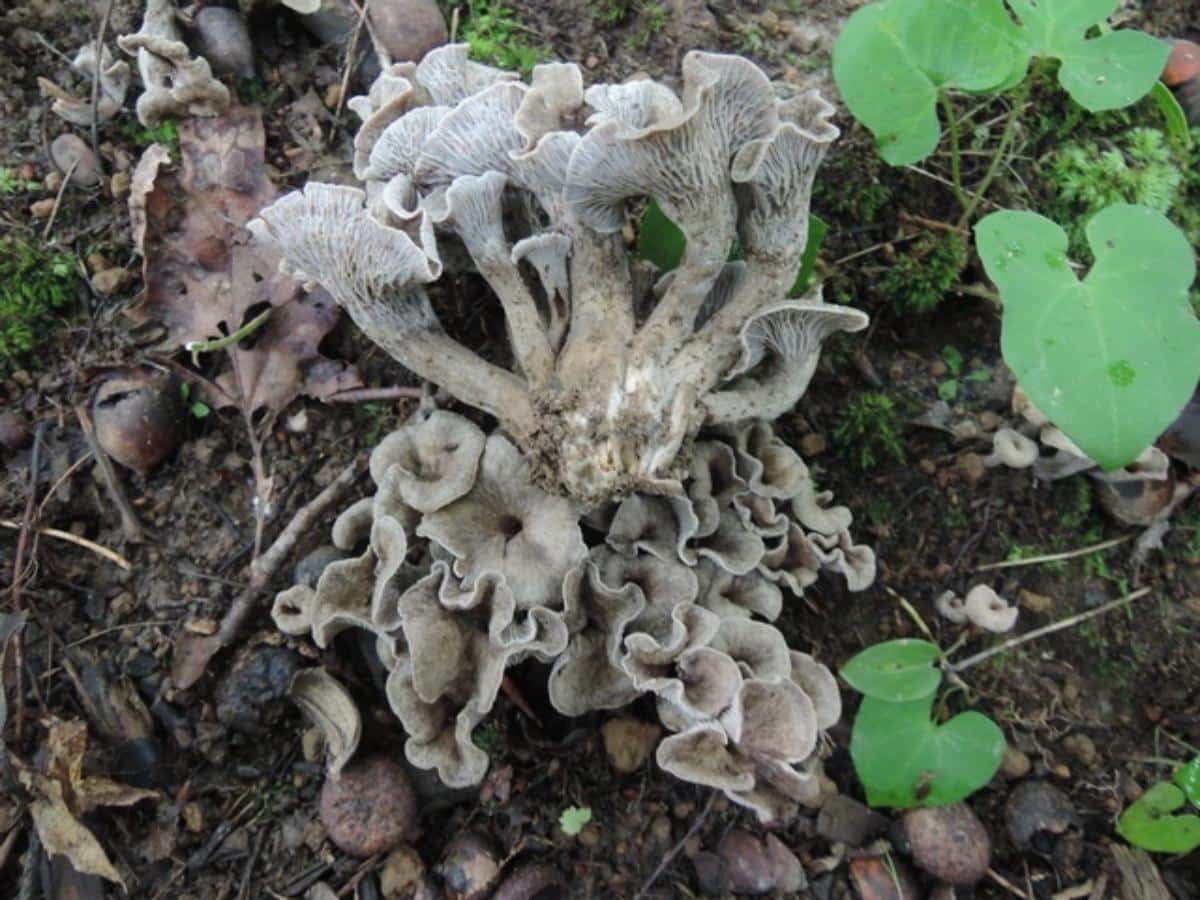
Craterellus cinereus, also listed as Craterellus caeruleofuscus (Widespread?)
This trumpet species is widespread across North America, but based on the Mushroom Observer’s observations, it seems to be a more “coastal” species, with possibly no distribution in the middle of the country. It distinguishes itself from the other black trumpets with extremely well-developed false gills that look like veins running up and down the entire body. It differs from C. foetidus above by the spread and extent of the false gills and its darker coloring.
It most often grows in association with beech trees and it is not uncommon to find it in the vicinity of other black trumpets like C. fallax.
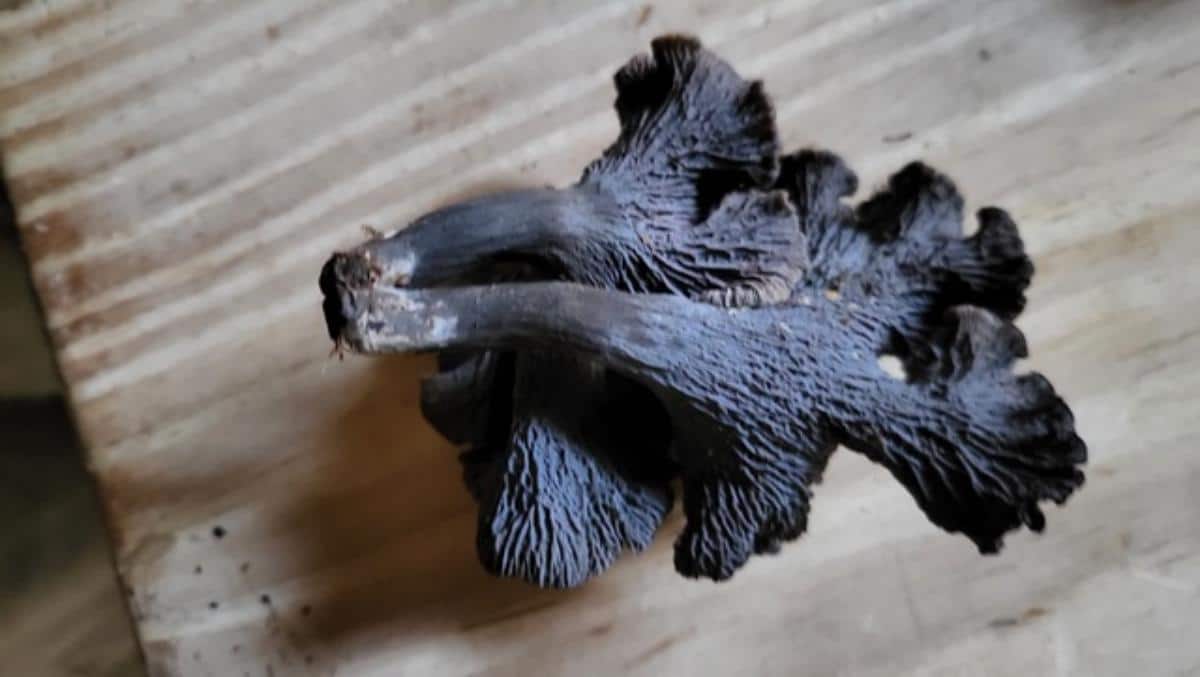
Craterellus calicornucopioides – California Black Trumpet
The California black trumpet looks extremely similar to the European type, but DNA says they are different. It is more robust than the east coast types, and commonly grows in dense, tight clusters.
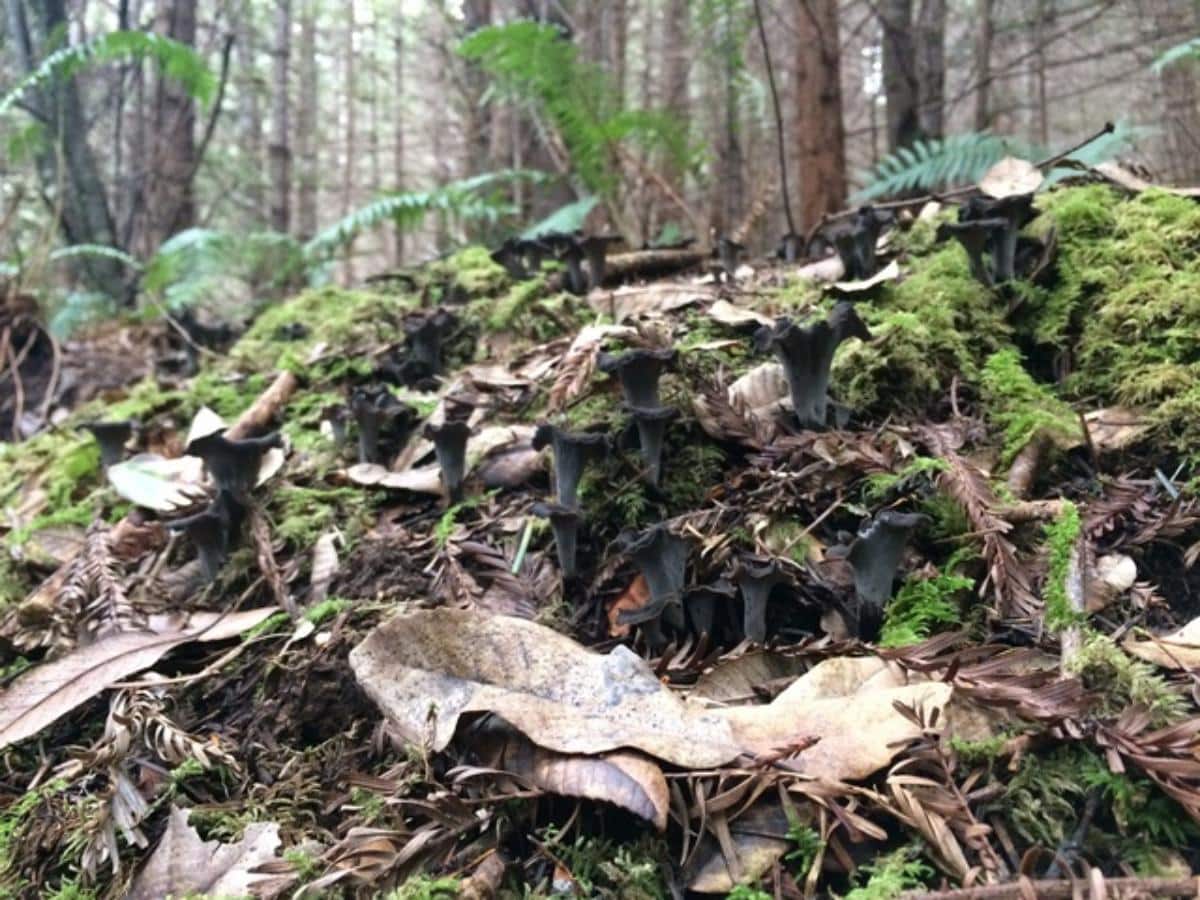
Look-Alikes
Devils Urn (Urnula craterium)
Fortunately, the devil’s urn is not poisonous, it’s just not as tasty. They have a more cup-like appearance and fruit in the spring (black trumpets fruit in the summer and fall).
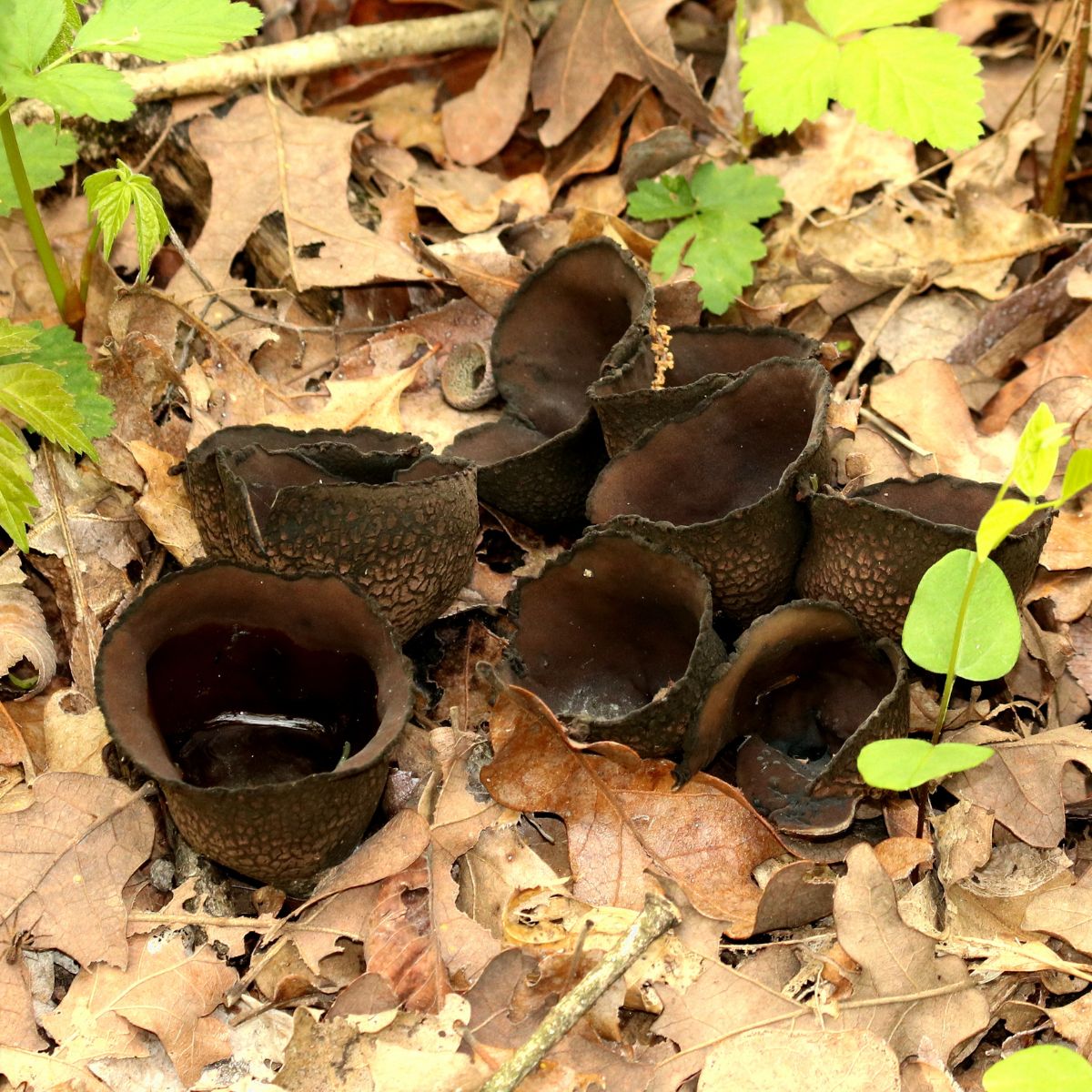
Blue Chanterelles (Polyozellus multiplex)
Blue chanterelles are choice edible mushrooms that resemble Black Trumpets. Blue chanterelles are generally deep blue-black and always grow in clustered growth. They’re also fairly uncommon to rare and only occur at high elevations.
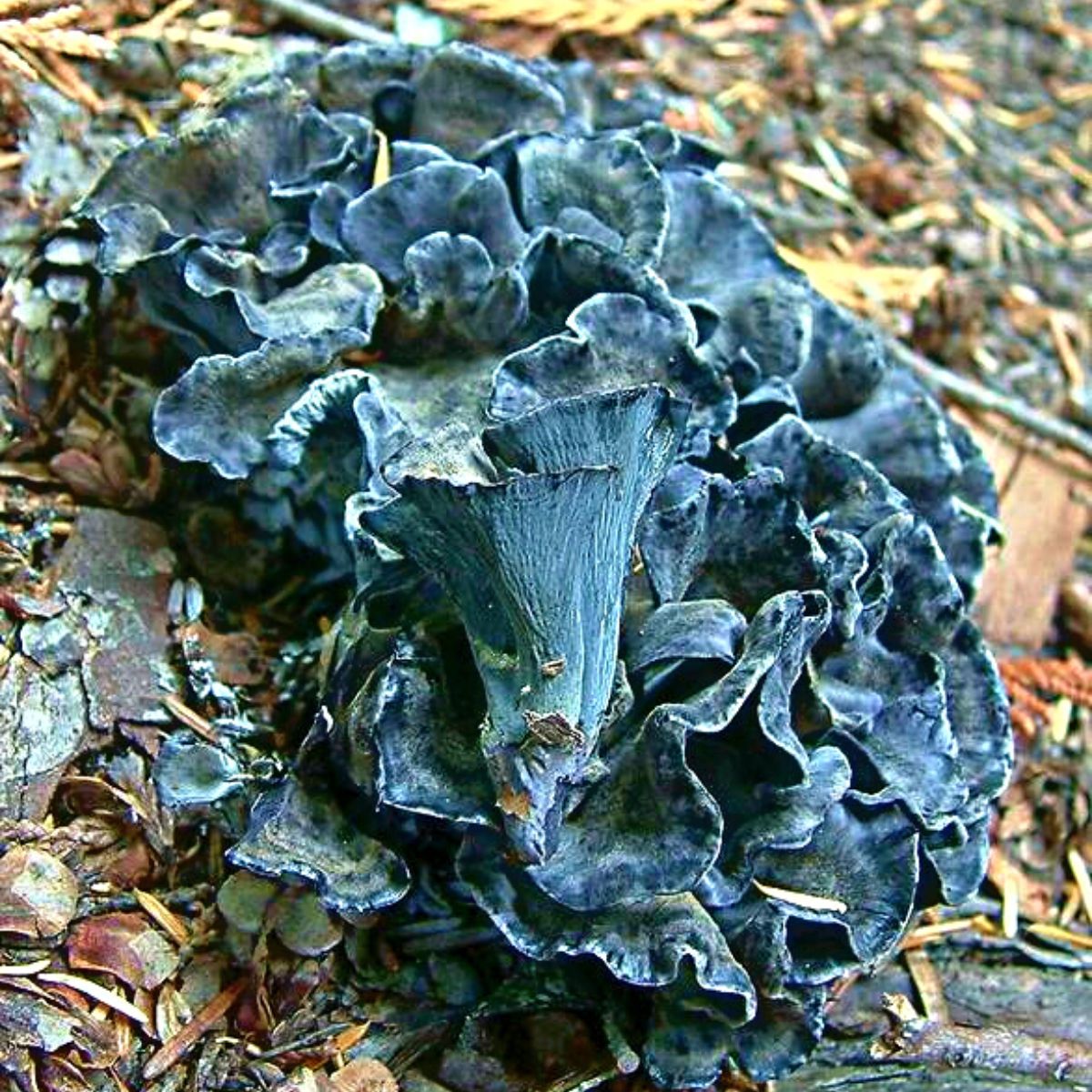
Pigs Ears (Gomphus clavatus)
Pig’s ears are thicker and fleshier than Black Trumpets and always grow in fused clusters. They have a lavender-gray or pink-brown color that can be confused with lighter specimens of Black Trumpets.
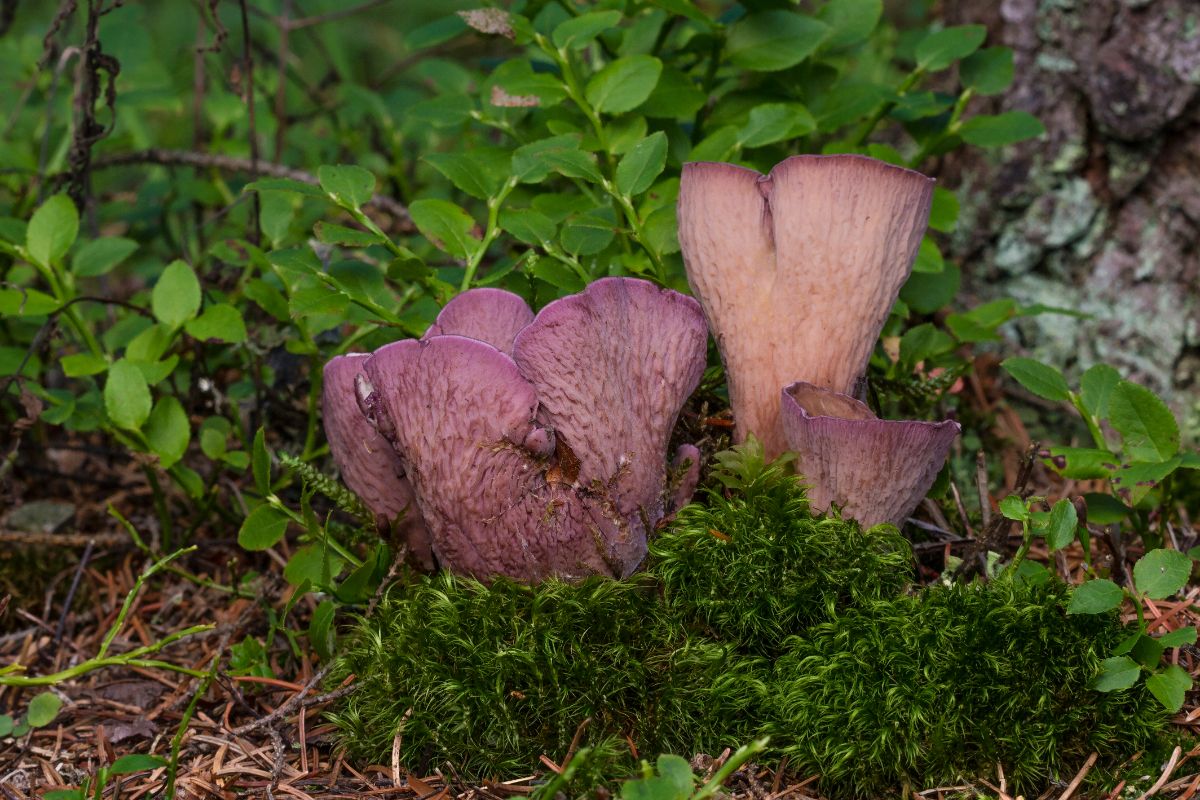
Tasty Trumpets – Cooking With Black Trumpets

Black trumpets are popular edible mushrooms. They have a rich, smoky flavor that is far better experienced than described.
Their deep flavor works well in many recipes. They’re a great addition to soups, sauces, pasta dishes, seafood recipes, or meals with any sort of meat. Basically anything without a lot of other strong tasting ingredients that will overshadow your delicious trumpets!
If picking them from the wild, be sure to clean them well before eating, as they can be gritty. Since the flesh is so brittle simply tear them apart by hand and gently wipe the insides and outsides clean. If you see a lot of dirt it’s okay to give them a quick rinse.
Black trumpets hold their flavor and keep very well dried. If you have too many, dry them out in a dehydrator or on a sheet in the oven on the lowest setting. The dried mushrooms can then be chopped or powdered, and used to add flavor to recipes or white wines.
Add your dried mushroom powder to rice dishes, or even couscous. Use it to make flavored butter. Once you start thinking about it as a spice you’ll love how it can be used to flavor so many meals!
Below are two easy mushroom recipes. The first one is a simple sauté that allows their rich taste to shine. The other uses them as a topping for fish.

Simple Trumpet Sauté
Ingredients:
- 8 oz fresh black trumpets
- 1 clove garlic, minced
- 2 cans vegetable or chicken broth
- 1 tbsp olive oil (or unsalted butter)
Heat oil in a large, non-stick skillet over medium-high heat. Sauté garlic for about 2 minutes.
Add cleaned mushrooms, and cook for about 5 minutes.
Remove from heat and serve. Easy!
Salmon with Trumpet Sauce
Ingredients:
- 2 – 4 medium salmon filets
- 3/4 – 1 lb fresh black trumpets, chopped (the more, the better!)
- 1 clove garlic, minced
- 1/3 cup chopped green onion
- 1/2 cup broth (vegetable, chicken, fish, whatever works for you)
- 1/2 cup white wine
- 1/2 stick butter
These instructions are for the mushroom topping. Cook the fish according to the directions on the packaging.
In a heavy skillet on medium heat, melt the butter. Once it’s melted, add the garlic and cook for 1 minute.
Add your cleaned and chopped black trumpets and sauté them for 5 minutes. Next add the chopped green onion and cook until they’re slightly wilted, usually another minute or two.
Add the wine and broth. Continue to cook until the volume of all the liquids is reduced by about half.
Remove from heat and season with any desired salt and pepper. Serve on top of the cooked salmon.
Variations:
- Add a few tbsp of cream after the liquids are reduced.
- Season with a tsp or your favorite herb.
- Using dried mushrooms instead of fresh works fine too. Reconstitute them by simmering in white wine.
- A few tbsp of lemon or orange juice adds a citrus flavor to the fish mixture.
Here are some mouth-watering Black Trumpet Mushroom Recipes:
- Caramelized Black Trumpets and Shallots
- Wild Black Trumpet Mushroom Spread
- Black Trumpet Risotto
- Black Trumpet Pizza
- Wild Mushroom Soup with Black Trumpet Sauté
Hopefully, these recipes and info will help you gain an appreciation for the black trumpet. Now the next time you’re in the woods, don’t forget to look for those black holes!


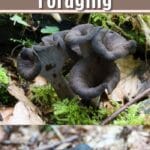
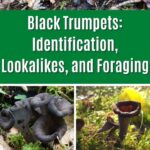
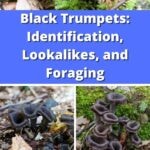
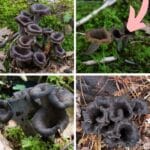
Daniel Walker
I found trumpet today but it was huge and had hedgehog like teeth handing down. 5 inches across the trumpet and stood 5 inches from the ground. It was in a cluster of 4 coming from the grass. It was almost black but more brown. Strong aroma.
It does not match photos of a Black Trumpet.
Very curious to ID and edibility.
I live in Central Ohio and found above on July 10, 2023
Jenny
Can you submit the photo to our facebook group – and make sure to read the announcements about what information is needed for a good id. I have an idea what it is but pics are necessary. Mushroom Lovers FB Group
David Spahr
Craterellus fallax was changed to cornucopiodes in 2001 by Moncalvo I think based on DNA. Then it was changed back in 2010 by Metheny also based on DNA. I think DNA changes will go though a big shake up soon. Read this (a bit dense) https://www.frontiersin.org/articles/10.3389/fevo.2022.859099/full
Fungurl
I found a thing is that very much resembles the Black trumpet however these were scattered and more symmetrical some of them were so close to the ground they were like little circles emerging and then becoming slightly taller funnels. Many of them had small bits of vegetation growing through their centers. Unfortunately I don’t have a picture of them growing in the field where I spotted them but there was sandy soil, a mainly eastern coast scrub pine trail beside a swampy marshy freshwater area.. I think it was adjacent to a cranberry bog. I have a photo of one I brought home it looks so similar to a black trumpet but that’s all that came up when I tried an image search.. there’s no odor. There is a little stem growing through the middle that I thought was adorable. Especially when they were leaves on it still!
Some of the flatter specimens had these faint concentric rings on the upper surface, reminding me of turkey tail slightly. It actually has sort of the texture of turkey tail too. Very little moisture.
Jenny
Usually I need to see pics, but based on your excellent description, I think what you found might be this (or something similar) — https://en.wikipedia.org/wiki/Phellodon_niger
Is the underside smooth or does it have little teeth like spines or pores? Black trumpets always have smooth outsides and insides
Lorenzo
Great article. I found a large cluster (C. fallax) this year in a deciduous forest, but most were near (within one foot) of Witch Hazel bushes, which I thought was interesting.
Jenny
That is interesting! I haven’t heard of them around witch hazel before, maybe others have experienced this? Thanks for sharing!